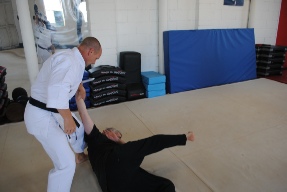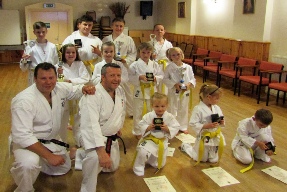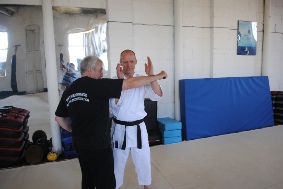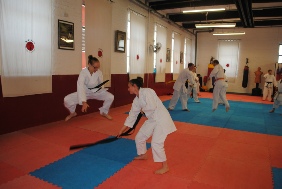









Welcome to TradKA UK. TradKA UK offers you all the facilities to be able to manage your Association effectively.
The Association is a direct member of several leading and major International Association most notably the Federation of English Karate Organisations and the International Okinawan Kobudo Association.
Through these Association TradKA UK is linked to the World Union of Karate Do Federations and the World United Karate Organisation.
TradKA UK’s Head of Association serves on the FEKO Executive. Several of TradKA’s member associations are led by distinguished names in their chosen martial art(s).
TradKA UK offers you Membership of an Association that focuses on quality while at the same time remembering the importance of autonomy.
Membership of TradKA UK is free with minimal single registration costs for individuals.
Although TradKA UK welcomes applications from large clubs/associations it can help smaller organisations whose numbers restrict them from joining some of the larger organisations. TradKA UK provides the same support to these clubs and can then assist and guide them with membership of larger organisations. Obviously quality is of importance and we must work within key policies, a copy of which can be viewed by clicking here.
Tradka UK offers the following for organisations searching for quality:
- Insurance,
- Certification,
- Licensing,
- Grade Ratification,Grade registration,
- Governing Body Recognition





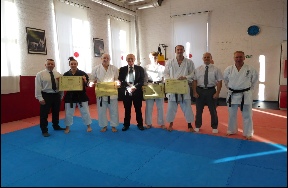
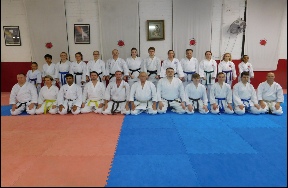




CORONAVIRUS
FEKO ASSOCIATIONS: RETURN TO INDOOR TRAINING – GENERAL GUIDANCE 22 JULY 2020
Government Guidance can be found https://www.gov.uk/guidance/working-safely-during-coronavirus-covid-19/providers-of-grassroots-sport-and-gym-leisure-facilities
This guidance is intended to assist Associations to consider safeguards against the spreading of the COVID 19 virus whilst allowing for a phased return to full martial arts training. It will be updated as and when new information is received.
It must be noted that Associations will need to follow any further regulations that are required by any facility they might use. This guidance should be followed in conjunction with any such requirements. You should ensure that you are able to evidence that you and the facility management have agreed, established and maintained the correct COVID 19 safety measures.
Associations with private dojos will be further bound by regulations that will have been laid down by their local authority inspection.
Association risk assessments must be tailored to their specific training environments.
Social distancing means is defined as staying alert and safe. In terms of actual distance this means staying apart for at least 2 metres unless you can mitigate for 1 meter plus. In the dojo social distancing means giving everyone training a total of 9.3 square metres 100 square foot) providing there is adequate ventilation.
Preparation/Planning
Each association must ensure the following:
1. There should be sufficient signage around the dojos to point out directions, the importance of regular handwashing and social distancing.
2. Spectators, including parents, should not be allowed into the dojo and should wait outside.
3. Safe and orderly entry and exit to the club dojos observing social distancing protocols of 2 metres.
4. Members, queuing outside must observe and maintain social distance. They should not enter the dojo until invited.
5. There should be a mandatory health check on arrival. A simple health check questionnaire should be completed asking if the member has experienced any illness since the previous session. Should a member report having any symptoms of COVID 19, then they must not be allowed to train and must report immediately to the NHS for a formal test. Instructors must make a clear note of such an occurrence. Every person is temperature checked on arrival (handheld devices are readily available from various sources online). Anyone with a raised temperature must not be allowed to train. For those that hire facilities, this check might be conducted by the facility management (instructor must check). Anyone showing any signs of the coronavirus must not train and contact the track and trace service.
6. The dojo must have clear markings where each person should stand. Everyone must be allocated 9.3 square metres (100 square feet) based on calculations using the dojo area, toilet, and changing facilities. The member should occupy the middle of that square. This is to ensure that adequate distance is always maintained, even during practice. A member can occupy other parts of their allocated space, but all members in the class must occupy the same space within their allocated area, which maintain social distancing. An instructor must constantly observe that social distancing is maintained throughout training
7. The dojo must always be ventilated as best as possible with doors and windows open unless otherwise directed by the facility provider. The area must be well ventilated and systems that simply recirculated the same air are not acceptable ventilation systems. It is recognised that some modernised facilities will have appropriate ventilation. In facilities where such ventilation is not available, the appropriate risk assessment must be undertaken to identify how this can be mitigated.
8. On entry, a member must be directed to a designated marked position and wait for the session to begin. This may be particularly challenging for our younger members who must be constantly monitored. A full explanation will help to maintain this.
9. Members should arrive changed and ready. It is anticipated that changing rooms will not be open. There should be no changing in toilets, or the dojo. There is still debate about whether shoes are safer than bare feet. It is recommended that each association clarifies this with their local public health authority.
10. Preferably, sessions should be pre-booked.
11. Payments for sessions should be contactless where possible.
12. A record of contact details of all those that attend sessions must be kept assisting the Government’s track and trace programmes. Clubs are legally obliged to ensure they have this information. Members must be advised of this record, and that they do not have a choice to ‘opt-out’ of this obligatory requirement.
13. Soap and water hand washing id the preferred option but in any event cleansing gel needs available and used as additional cleansing before and after practice. It is the responsibility of both the instructors and the members to ensure that antibacterial gel is readily available. Paper towels should be provided.
Training/Practice
1. Only NON-CONTACT training is allowed at this time. Though some family groups could practice with contact, this should not happen in ‘public’ sessions as it will give the wrong impression and must not form any part of the community training programme at this time
2. Drilling in moving lines (like marching) is only allowed if members are in a single rank and have clear ‘lanes’ to move up and down. There must be no entry into another person’s marked space at any time.
3. There should be no kiai. Forcefully driving air from the body (as in shouting) increases the risk of droplets being spread and would require greater social distance needed between members as well as potentially infecting surfaces around the members. In this context, Instructors need to be mindful of their calls/commands and should seek to increase the distance between themselves and the assembled class.
4. All forms of face coverings may restrict breathing efficiency and should not be used during exercise except on specific advice from a Doctor. If they are to be used, then the following is recommended:
- Wash hands thoroughly with soap and water for 20 seconds or use hand sanitiser before putting a face covering on, and after removing it
- Avoid touching the face or face covering
- Change face covering if it becomes damp or if it has been touched
- Continue to wash hands regularly
- Change and wash the face-covering daily
- If the material is washable, wash in line with the manufacturer’s instructions. If it is not washable, dispose of it carefully in the usual waste
5. Sharing of any equipment is prohibited.
6. Instructors must refrain from guiding or touching any members limb during practice.
7. If toilets are used, they must be cleaned immediately following use. The hands must be washed thoroughly, and paper towels disposed of properly.
Post Session
At the end or between sessions
1. Members must leave the dojo is an orderly and organised fashion. They must leave as they arrived and change at home.
2. All members are advised to immediately shower on returning home.
3. All members MUST clean their training clothes (gi or otherwise) between sessions.
4. Any congregating of people must be away from the dojo and outside, whilst maintaining social distancing protocols. The social aspects of a club should not be under-estimated as it contributes to the overall well-being of members, but these activities must be conducted in line with government guidance.
5. There must be no hugging or embracing between members at any point, but especially after a session when members are likely to have been perspiring.
6. If the session is in between sessions, then all surfaces must be cleaned using an appropriate steriliser.
7. If multiple classes are held over the day/evening, the instructor must allow adequate time between classes for clearing and cleaning of the dojo. This is to ensure and minimise the risk of contamination and maintaining social distancing. There must be no over-crowding at any time around entrances and exits.
8. There must be no shared use of drinking bottles at any time.
It is recognised that implementing the above measures will place significant pressure on time and space. Class sizes will more than likely reduce in number, and perhaps need to be shorter, which in turn places pressure on finances. However, these measures are mandatory if clubs wish to train in their dojo.
IN SUMMARY
- The dojo and facilities must be thoroughly cleaned before returning to training.
- Temperatures must be taken and anybody found to have a high temperature should not be allowed to train. Anyone who displays COVID symptoms should leave and arrange for testing.
- Class timetables should be adapted to allow for social distancing.
- When waiting to enter or leaving the dojo, social distancing of 2 metres should be maintained.
- Changing rooms should not be used except for people with disabilities and those with special needs.
- When training each individual must have a minimum of 9.3 square metres (100 square feet) subject to adequate ventilation.
- Classes must not include any contact training whatsoever including those from the same ‘bubble’.
- Equipment should not be used.
- Following training, all areas which have been used should be cleaned.
- Touching any part of the face should be discouraged while regular handwashing and/or hand sanisitisation should be strongly encouraged.

The Sport England approved Return to Training Guidance for all karate in England can be found on the FEKO web site at www.feko.co.uk
For any other training, please consult the approved Return to Play Policies on the relevant web site. The list of approved organisations can be found at:
